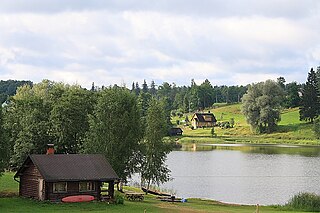Rebase may refer to:
- Rebasing, a computer process
- Rebase, Estonia, a village in Estonia
Rebase may refer to:
The Portable Executable (PE) format is a file format for executables, object code, DLLs and others used in 32-bit and 64-bit versions of Windows operating systems, and in UEFI environments. The PE format is a data structure that encapsulates the information necessary for the Windows OS loader to manage the wrapped executable code. This includes dynamic library references for linking, API export and import tables, resource management data and thread-local storage (TLS) data. On NT operating systems, the PE format is used for EXE, DLL, SYS, MUI and other file types. The Unified Extensible Firmware Interface (UEFI) specification states that PE is the standard executable format in EFI environments.
In computing, rebasing is the process of modifying data based on one reference to another. It can be one of the following:

Neoschizomers are restriction enzymes that recognize the same nucleotide sequence as their prototype but cleave at a different site. In some special applications this is a very helpful feature.

Kambja Parish is a rural municipality in Tartu County, Estonia.

An Estonian House is a center of Estonian culture, usually overseas. Numerous Estonian Houses were set up after the Soviet occupation of Estonia led to tens of thousands of Estonian people fleeing the war and the occupation and settling overseas.

Rõuge Parish is a rural municipality of Estonia, in Võru County. In 2019, it had a population of 5,427 and an area of 933 km².

Misso Parish was a rural municipality of Estonia, in Võru County. It had a population of 780 and an area of 189.35 km2.

Paistu Parish was a rural municipality of Estonia, in Viljandi County.
DCSS could refer to
Estonian may refer to:
Rebase is a village in Kambja Parish, Tartu County in eastern Estonia.
Rebase is a village in Viljandi Parish, Viljandi County, Estonia.

Urmas Kruuse is an Estonian politician who has been the Minister of Rural Affairs since 2021. From 2014 to 2015, he was the Minister of Health and Labour. He is member of the Estonian Reform Party.
Sepp is a surname. When borne by Estonian-descended people, it is usually derived from sepp meaning "smith".

Viljandi Parish is a rural municipality of Viljandi County, Estonia. It is located around the town of Viljandi, but does not include it.
Undefined may refer to:

Frichs is a Danish company based in Horsens, founded in 1854 in Aarhus. Frichs today produce ship engines but started out in the 19th century producing a long range of farm and industry equipment, ships, church bells, cranes and later through the 20th century locomotives and train carriages. In the early to mid 20th century it was a major company and employer in Aarhus at its height employing some 1000 people. The company was the sole Danish supplier of locomotives for the Danish State Railways from 1919 to the mid 1950s and sold locomotives across Europe and to Siam and New Zealand. In 1980 the company was sold to Kosan and then restructured and rebased to Horsens.

KDE neon is a Linux distribution developed by KDE based on Ubuntu long-term support (LTS) releases, bundled with a set of additional software repositories containing the latest versions of the Plasma 5 desktop environment/framework, Qt 5 toolkit and other compatible KDE software. First announced in June 2016 by Kubuntu founder Jonathan Riddell following his departure from Canonical Ltd., it has been adopted by a steadily growing number of Linux users, regularly appearing in the Top 20 on DistroWatch.com's popularity tables.
The one hundred kwacha note of Zambia is a denomination of the Zambian currency. The current paper note, first issued in 2013 features the Freedom Statue in Lusaka, the issuing authority of legal tenders in Zambia, in the middle there is the National Assembly, the face value of the banknote in words in the lower left corner, and in numerals in the other three corners and the new printer imprint Giesecke & Devrient at the lower right corner, there is also a Buffalo on the reverse. The obverse features the African fish eagle which is considered as the primary recognition of the Zambian banknote, together with the coat of arms, the signature of the Bank of Zambia Governor and obligation to pay the sum indicated on the banknote, and the face value of the specified banknote and the Baobab Tree. It is the highest denomination of banknote issued by the Bank of Zambia since January, 2013 when the three zeros from the preexisting denomination K500, K1,000, K5,000, K10,000, K20,000 and K50,000 were removed.
Rebäse is a village in Rõuge Parish, Võru County in Estonia.